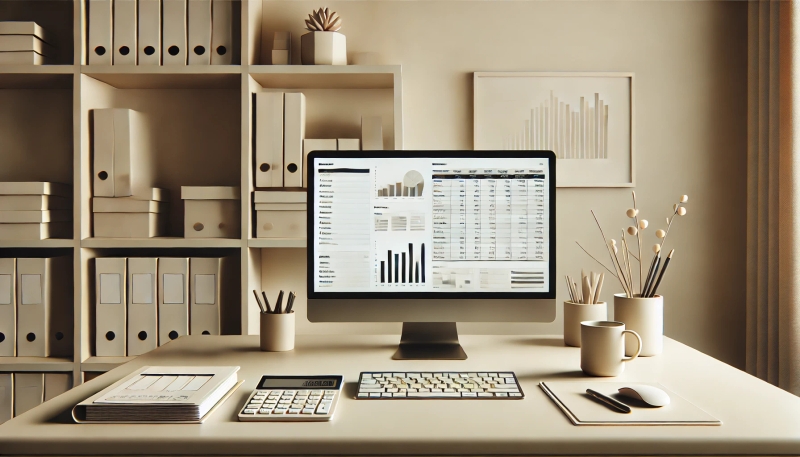Starting a small business can feel like you're wearing every hat at once.
From marketing to customer service, and, of course, managing the finances, it’s easy to get lost in the chaos.
But amidst the whirlwind, there’s one tool that can make everything clearer – a profit and loss (P&L) statement.
Now, before you get intimidated by the finance jargon, let us stop you right there.
A P&L statement isn’t designed just for big corporations or accounting professionals. It’s one of the most important documents for small business owners to stay on top of their money.
The sooner you create it, the sooner you take control of your company’s finances.
And guess what? It’s simple once you break it down.
What is a profit and loss statement?

A profit and loss statement is a financial document that summarizes your business’s income and expenses over a period of time.
Think of it as a report card for your business that shows how much money you’re making (or losing) after factoring in all your costs.
At its core, it boils down to this equation:
Total Revenue - Total Expenses = Net Profit (or Loss)
That’s it. Simple math that gives you a clear picture of your financial health.
Why every small business needs a P&L statement
Better financial management
Let’s be honest, managing a business is exciting, but it can quickly get messy if you don't have a handle on your finances.
That’s where a profit and loss statement comes in.
It's a financial snapshot that gives you the full picture of what’s going on with your money:
- how much you’re earning
- how much you’re spending
- and, most importantly, how much is left over.
Essentially, a profit and loss statement breaks down your revenue and expenses.
It helps you see where the money is coming from and where it’s going. You're not merely fighting for dollars and cents here – you're trying to find out if you're operating a healthy, sustainable business.
You don't want to incur unexpected costs or, even worse, discover that you've spent more than you earned in a specific period.
There are cases where it's a calculated risk, but for the most part, you want to end the financial year well.
Financial statements like a profit and loss statement and balance sheet keep dark scenarios from happening by giving you a clear roadmap.
But there’s more to it.
Easier tax filing
When tax season rolls around, nothing’s worse than scrambling to find receipts or trying to piece together a year’s worth of transactions.
With a well-maintained profit and loss statement, you’ve already organized everything in one place.
It can save you time and reduce stress. And, if you have an accountant, they’ll thank you for making their life easier. Filing taxes becomes smoother process when you can easily see your income, deductions, and expenses.
Flexibility
The real beauty of a profit and loss statement? It’s flexible.
Every business is unique – whether you’re selling products, providing services, or doing a mix of both, your P&L can be customized to fit your needs.
- Have a second job? You can use a stripped-down version that only includes a few categories.
- Juggling multiple clients? You can tailor your P&L to track income and expenses per project. With this, you can quickly identify the clients or projects that generate the most profit.
- Running a non-profit? You can customize your P&L to include donations, grants, and specific program expenses, helping you manage your funding and stay within budget for each initiative.
- Managing a retail store? You can split your P&L to track in-store and online sales separately, with inventory costs, to see which channels or products contribute most to your bottom line.
It’s all about making it work for your business, regardless of size or complexity.
Let’s say you’re a freelancer with a few clients.
A basic profit and loss statement template can help you track what each client is paying you, with any related expenses – like software subscriptions, website hosting, or contractor fees.
On the other hand, if you’re selling handmade t-shirts, you might need to keep track of:
- production costs
- packaging
- shipping fees
- any marketing expenses.
No matter the type of business, your profit and loss statement can give you a simple but effective view of what’s working and what’s not.
Informed decision making
And let’s not forget one of the biggest benefits: an evidence-informed approach.
When you have a clear view of your income and expenses, it’s easier to make smart choices about your business.
- Want to invest in new equipment? You can check your profit and loss statement to see if your budget allows for it
- Thinking about hiring help or launching a new product? The numbers on your P&L can help you decide if it’s the right move
- Planning to expand your business? You can use your P&L to assess whether your current financial position supports opening a new location or expanding into a new market
- Looking to cut costs? Your P&L can highlight areas where expenses are higher than expected – so you can identify opportunities for cost savings or renegotiating contracts to improve your profit margins.
With a profit and loss statement, you get a financial compass that points you in the right direction and helps you avoid costly missteps.
Key elements of a profit and loss statement

Most small business owners don’t realize how much money they lose until it’s too late. That’s why understanding the main elements of P&L statements is so important. Below, you’ll find all the key parts of a P&L statement.
#1 - Revenue
Revenue is the money flowing into your business from all sources. Tracking revenue carefully is the first step in understanding your business's financial health. In the P&L statement, there are two basic types of revenue to include:
Sales income
This is your business’s bread and butter – how much money your organization brings in from selling its products or services.
On the profit and loss statement, it can also be called gross sales or net sales, and it usually represents the majority of your company's revenues. It's a key part of any financial statement as it helps you understand your revenue during the reporting period.
Other income
Sometimes, businesses have income streams outside of their main operations.
These could be interest earned, rental income, grants, or other streams.
You should keep them separate from gross revenue on your P&L so you can see exactly where your revenue is coming from and plan further business steps based on it.
This distinction also comes in handy when reviewing your company's financial performance – or when you're trying to determine profitability.
#2 - Expenses
Expenses can quickly eat into your profits if you’re not paying attention.
From the costs directly tied to your products to the everyday bills that keep your business running, tracking expenses is just as important as tracking net revenue.
Let’s break down the key types of expenses that show up on a profit and loss statement.
Cost of Goods Sold (COGS)
If you sell physical products, it's where you track the cost of goods sold – things like raw materials, interest expenses, and direct labor costs tied to creating your product.
If you're a service-based business, your COGS might be indirect (including e.g., subcontractor fees).
Knowing your COGS helps you calculate gross profit, which is simply your gross sales minus the goods sold. It gives you a helicopter view of how much money you're making before other expenses come into play.
Operating expenses incurred
These are all the costs needed to keep the business running.
Think rent, utilities, marketing, and salaries. Operating expenses are key in determining your operating income, which shows how profitable your core business is without considering taxes or interest.
A breakdown of these expenses into specific categories on your P&L makes it easier to see where your money is going and how it's affecting your company's profitability.
Miscellaneous expenses
Every business has random costs that don’t quite fit into other categories.
These might be interest on business debt, parking fees, small office supplies, or unexpected maintenance costs.
On your profit and loss statement, these are sometimes labeled as other expenses or non-operating expenses, and though they might seem minor, tracking them is important for understanding all the expenses you're incurring.
They can affect your net profit margin in the long run.
#3 - Net profit/loss

This is the moment of truth – total revenue minus total expenses.
The result is your net income (or net loss if you're spending more than you're earning).
The net profit on your P&L is the figure that tells you how your business is doing. If you have net earnings, you’re on the right track.
If the number is negative, it means the business might need adjustments to cut costs or increase revenue.
Net profit margin also gives insight into how efficiently the business is running and its overall financial health.
#4 - Customizable sections
A great thing about our profit and loss template is its flexibility. Every business is different, and you can adjust the template to fit your business's financial performance.
Here are some sections you might want to add:
Seasonal income/expenses
If your business experiences seasonal ups and downs, this section can help you track income and expenses for the high and low periods. You get a more detailed view of your company's financial performance during peak times versus slow ones. Seasonal changes in your total revenue can show up in these sections.
Taxes and depreciation
As your business grows, you might start dealing with more complex costs like income tax expenses or depreciation of equipment. Including these in your financial report helps you see how these factors affect your overall financial results. Plus, having a section for income tax expenses makes things easier when it’s time to file.
Owner’s draw
If you're a sole proprietor, tracking how much money you’re taking out of the business (known as the owner’s draw) helps you see how much profit is being reinvested versus how much is being used for personal expenses. This can help you better manage cash flows and improve your company's ability to grow.
Why track these key elements?
Tracking all these categories in your profit and loss statements is more than a formality.
It’s all important for:
- understanding the company's financial health
- spotting trends
- making informed decisions about the future.
Reviewing your income statement, alongside other small business financial statements like the balance sheet and cash flow statement, gives you a full picture of your financial performance. For instance, balance sheets show your company's assets, liabilities, and equity.
Are your operating expenses too high? Is your gross profit margin shrinking?
These are the kinds of questions your P&L statement should help you answer.
If the P&L statement is done right, it should help you understand where you’re making money, where you’re spending it, and what you can do to improve your bottom line.
Keeping a regular, up-to-date profit and loss statement is for anyone who wants to stay on top of their finances.
Small business self-employed profit and loss statement template
Don’t overcomplicate things! The goal here is to create something that’s easy to create, but even easier to fill in and understand. You don’t need to know all the technical accounting terms to make this work.
Here’s a simple template you can use as a starting point. Feel free to adjust the categories based on what works for your business.
Note: This is just a basic structure. You can easily modify the categories to suit your specific business. For instance, if you handle inventory, you could add a section for storage fees. Or, if you frequently deal with travel, you could include a category for business travel expenses.
Get started today
Now that you have the basics down, it’s time to put this into action. You can copy our template, adjust it as needed, and start using it today. Keeping track of your income and expenses doesn’t have to be a headache!
Start simple, stay consistent, and watch your business grow. And hey, while you’re at it, you might want to check out an even better way of managing your business's finances: Capsule CRM! Pair it with accounting software like Xero or Quickbooks and you will have a well-oiled accounting machine.




